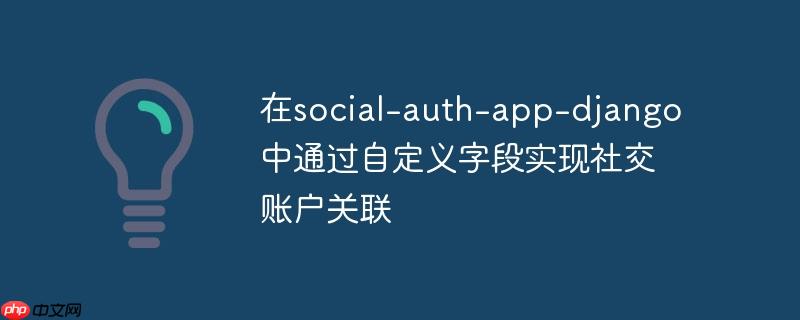
在django项目中,我们经常会使用自定义用户模型(abstractuser的子类)来存储额外的用户属性。例如,一个名为profile的用户模型可能包含一个独特的telegram_id字段,用于存储用户的telegram id:
import uuid
from django.contrib.auth.models import AbstractUser
from django.db import models
class Profile(AbstractUser):
id = models.UUIDField(primary_key=True, default=uuid.uuid4, editable=False)
# ... 其他字段
telegram_id = models.BigIntegerField(verbose_name='телеграм ID', unique=True, blank=True, null=True)
# ...当集成social-auth-app-django进行社交登录(如Telegram、Google、VK)时,一个常见的需求是:
social-auth-app-django通过其管道(pipeline)机制处理用户认证和关联。默认的管道流程如下:
SOCIAL_AUTH_PIPELINE = (
'social_core.pipeline.social_auth.social_details',
'social_core.pipeline.social_auth.social_uid',
'social_core.pipeline.social_auth.social_user',
'social_core.pipeline.user.get_username',
'social_core.pipeline.social_auth.associate_by_email', # 默认通过邮箱关联
'social_core.pipeline.user.create_user',
'social_core.pipeline.social_auth.associate_user',
'social_core.pipeline.social_auth.load_extra_data',
'social_core.pipeline.user.user_details',
)默认管道中的associate_by_email步骤会尝试通过电子邮件地址关联用户。然而,对于像Telegram这样不直接提供电子邮件,但提供唯一ID的社交平台,我们需要一种自定义的关联逻辑。
为了实现通过自定义字段(如telegram_id)关联用户,我们需要创建一个自定义的管道函数,并将其插入到SOCIAL_AUTH_PIPELINE的适当位置。
以下是一个实现此功能的自定义管道函数示例:
from django.contrib.auth import get_user_model
from social_core.exceptions import AuthException
def associate_by_telegram_id(backend, details, user=None, *args, **kwargs):
"""
自定义管道函数,用于通过Telegram ID关联现有用户。
"""
# 仅针对Telegram后端执行此逻辑
if backend.name == 'telegram':
# 如果用户已经登录或已通过之前的管道步骤关联,则跳过
if user:
return None
# 从kwargs中获取社交平台提供的UID(通常是Telegram ID)
tgid_str = kwargs.get('uid')
if not tgid_str:
return None # 如果没有UID,则无法进行关联
try:
tgid = int(tgid_str)
except (ValueError, TypeError):
# UID不是有效的整数,可能是数据异常,记录日志或抛出异常
return None # 或者 raise AuthException(backend, "Invalid Telegram ID format")
UserModel = get_user_model()
# 尝试查找与该Telegram ID匹配的用户
users = list(UserModel.objects.filter(telegram_id=tgid))
if len(users) == 0:
# 没有找到匹配的用户,让后续管道步骤(如create_user)处理
return None
elif len(users) > 1:
# 发现多个用户绑定了同一个Telegram ID,这通常是数据异常,应抛出错误
raise AuthException(
backend, "The given Telegram ID is associated with multiple accounts"
)
else:
# 找到一个匹配的用户,将其返回以供后续管道步骤关联
return {"user": users[0], "is_new": False}
return None # 对于其他后端,不执行任何操作函数解析:
将上述自定义函数添加到settings.py中的SOCIAL_AUTH_PIPELINE中。它应该放在social_uid之后,associate_by_email和create_user之前,这样它才有机会在默认的关联和创建用户步骤之前执行。
# settings.py
SOCIAL_AUTH_PIPELINE = (
'social_core.pipeline.social_auth.social_details',
'social_core.pipeline.social_auth.social_uid',
'your_app_name.pipeline.associate_by_telegram_id', # 插入你的自定义管道函数
'social_core.pipeline.social_auth.associate_by_email',
'social_core.pipeline.user.get_username', # 注意:get_username可以放在这里或更早,根据你的需求
'social_core.pipeline.user.create_user',
'social_core.pipeline.social_auth.associate_user',
'social_core.pipeline.social_auth.load_extra_data',
'social_core.pipeline.user.user_details',
)请将your_app_name.pipeline.associate_by_telegram_id替换为你的自定义函数所在的实际模块路径。例如,如果你的函数定义在myproject/core/pipeline.py中,那么路径将是myproject.core.pipeline.associate_by_telegram_id。
通过以上步骤,你就可以在social-auth-app-django中实现基于自定义用户模型字段的智能社交账户关联,从而提供更灵活和健壮的认证体验。
以上就是在social-auth-app-django中通过自定义字段实现社交账户关联的详细内容,更多请关注php中文网其它相关文章!

每个人都需要一台速度更快、更稳定的 PC。随着时间的推移,垃圾文件、旧注册表数据和不必要的后台进程会占用资源并降低性能。幸运的是,许多工具可以让 Windows 保持平稳运行。

Copyright 2014-2025 https://www.php.cn/ All Rights Reserved | php.cn | 湘ICP备2023035733号